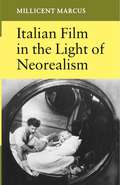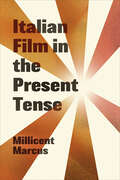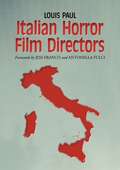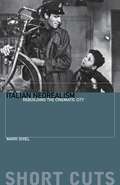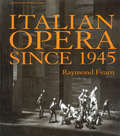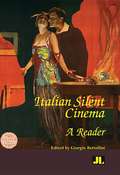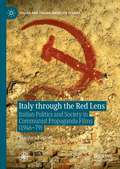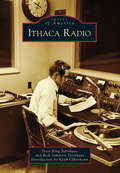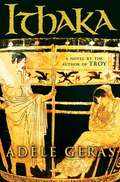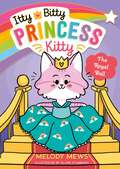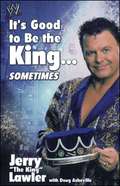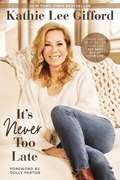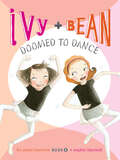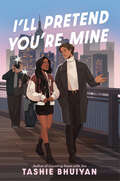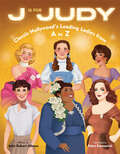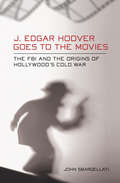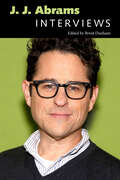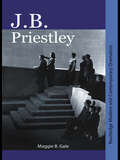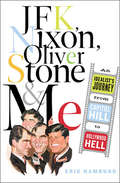- Table View
- List View
Italian Film in the Light of Neorealism
by Millicent MarcusThe movement known as neorealism lasted seven years, generated only twenty-one films, failed at the box office, and fell short of its didactic and aesthetic aspirations. Yet it exerted such a profound influence on Italian cinema that all the best postwar directors had to come to terms with it, whether in seeming imitation (the early Olmi), in commercial exploitation (the middle Comencini) or in ostensible rejection (the recent Tavianis). Despite the reactionary pressures of the marketplace and the highly personalized visions of Fellini, Antonioni. And Visconti, Italian cinema has maintained its moral commitment to use the medium in socially responsible ways--if not to change the world, as the first neorealists hoped, then at least to move filmgoers to face the pressing economic, political, and human problems in their midst. From Rossellini's Open City (1945) to the Taviani brothers' Night of the Shooting Stars (1982). The author does close readings of seventeen films that tell the story of neorealism's evolving influence on Italian postwar cinematic expression.Other films discussed are De Sica's Bicycle Thief and Umberto D. De Santis's Bitter Rice, Comencini's Bread, Love, and Fantasy, Fellini's La strada, Visconti's Senso, Antonioni's Red Desert, Olmi's Il Posto, Germi's Seduced and Abandoned, Pasolini's Teorema, Petri's Investigation of a Citizen above Suspicion, Bertolucci's The Conformist, Rosi's Christ Stopped at Eboli, and Wertmuller's Love and Anarchy, Scola's We All Loved Each Other So Much provides the occasion for the author's own retrospective consideration of how Italian cinema has fulfilled, or disappointed, the promise of neorealism.
Italian Film in the Present Tense (Toronto Italian Studies)
by Millicent MarcusFor observers of the European film scene, Federico Fellini’s death in 1993 came to stand for the demise of Italian cinema as a whole. Exploring an eclectic sampling of works from the new millennium, Italian Film in the Present Tense confronts this narrative of decline with strong evidence to the contrary. Millicent Marcus highlights Italian cinema’s new sources of industrial strength, its re-placement of the Rome-centred studio system with regional film commissions, its contemporary breakthroughs on the aesthetic front, and its vital engagement with the changing economic and socio-political circumstances in twenty-first-century Italian life. Examining works that stand out for their formal brilliance and their moral urgency, the book presents a series of fourteen case studies, featuring analyses of such renowned films as Il Divo, Gomorrah, The Great Beauty, We Have a Pope, The Mafia Only Kills in the Summer, and Fire at Sea, along with lesser-known works deserving of serious critical scrutiny. In doing so, Italian Film in the Present Tense contests the widely held perception of a medium languishing in its "post-Fellini" moment, and instead acknowledges the ethical persistence and forward-looking currents of Italian cinema in the present tense.
Italian Horror Film Directors
by Louis Paul<p>There is no cinema with such effect as that of the hallucinatory Italian horror film. From Riccardo Freda's I Vampiri in 1956 to Il Cartaio in 2004, this work recounts the origins of the genre, celebrates at length ten of its auteurs, and discusses the noteworthy films of many others associated with the genre. <p>The directors discussed in detail are Dario Argento, Lamberto Bava, Mario Bava, Ruggero Deodato, Lucio Fulci, Umberto Lenzi, Antonio Margheriti, Aristide Massaccesi, Bruno Mattei, and Michele Soavi. Each chapter includes a biography, a detailed career account, discussion of influences both literary and cinematic, commentary on the films, with plots and production details, and an exhaustive filmography. <p>A second section contains short discussions and selected filmographies of other important horror directors. The work concludes with a chapter on the future of Italian horror and an appendix of important horror films by directors other than the 50 profiled. Stills, posters, and behind-the-scenes shots illustrate the book.</p>
Italian Neorealism
by Mark ShielItalian Neorealism: Rebuilding the Cinematic City is a valuable introduction to one of the most influential of film movements. Exploring the roots and causes of neorealism, particularly the effects of the Second World War, as well as its politics and style, Mark Shiel examines the portrayal of the city and the legacy left by filmmakers such as Rossellini, De Sica, and Visconti. Films studied include Rome, Open City (1945), Paisan (1946), The Bicycle Thief (1948), and Umberto D. (1952).
Italian Neorealism: Rebuilding the Cinematic City (Short Cuts)
by Mark ShielItalian Neorealism: Rebuilding the Cinematic City is a valuable introduction to one of the most influential of film movements. Exploring the roots and causes of neorealism, particularly the effects of the Second World War, as well as its politics and style, Mark Shiel examines the portrayal of the city and the legacy left by filmmakers such as Rossellini, De Sica, and Visconti. Films studied include Rome, Open City (1945), Paisan (1946), The Bicycle Thief (1948), and Umberto D. (1952).
Italian Neorealist Cinema
by Christopher WagstaffThe end of the Second World War saw the emergence of neorealist film in Italy. In Italian Neorealist Cinema, Christopher Wagstaff analyses three neorealist films that have had significant influence on filmmakers around the world. Wagstaff treats these films as assemblies of sounds and images rather than as representations of historical reality. If Roberto Rossellini's Roma città aperta and Paisà, and Vittorio De Sica's Ladri di biciclette are still, half a century after they were made, among the most highly valued artefacts in the history of cinema, Wagstaff suggests that this could be due to the aesthetic and rhetorical qualities of their assembled narratives, performances, locations, lighting, sound, mise en scène, and montage.This volume begins by situating neorealist cinema in its historical, industrial, commercial and cultural context, and makes available for the first time a large amount of data on post-war Italian cinema. Wagstaff offers a theoretical discussion of what it means to treat realist films as aesthetic artefacts before moving on to the core of the book, which consists of three studies of the films under discussion. Italian Neorealist Cinema not only offers readers in Film Studies and Italian Studies a radically new perspective on neorealist cinema and the Italian art cinema that followed it, but theorises and applies a method of close analysis of film texts for those interested in aesthetics and rhetoric, as well as cinema in general.
Italian Opera Since 1945 (Contemporary Music Studies #Vol. 15)
by Raymond FearnFirst Published in 1998. Routledge is an imprint of Taylor & Francis, an informa company.
Italian Political Cinema: Figures of the Long ’68
by Mauro ResminiAn exploration of how film has made legible the Italian long &’68 as a moment of crisis and transitionTraditionally, the definition of political cinema assumes a relationship between cinema and politics. In contrast to this view, author Mauro Resmini sees this relationship as an impasse. To illustrate this theory, Resmini turns to Italian cinema to explore how films have reinvented the link between popular art and radical politics in Italy from 1968 to the early 1980s, a period of intense political and cultural struggles also known as the long &’68.Italian Political Cinema conjures a multifaceted, complex portrayal of Italian society. Centered on emblematic figures in Italian cinema, it maps the currents of antagonism and repression that defined this period in the country&’s history. Resmini explores how film imagined the possibilities, obstacles, and pitfalls that characterized the Italian long &’68 as a moment of crisis and transition. From workerism to autonomist Marxism to feminism, this book further expands the debate on political cinema with a critical interpretation of influential texts, some of which are currently only available in Italian.A comprehensive and novel redefinition of political film, Italian Political Cinema introduces its audience to lesser-known directors alongside greats such as Pasolini, Bertolucci, Antonioni, and Bellocchio. Resmini offers access to untranslated work in Italian philosophy, political theory, and film theory, and forcefully advocates for the continued artistic and political relevance of these films in our time.
Italian Science Fiction: The Other in Literature and Film (Studies in Global Science Fiction)
by Simone Brioni Daniele ComberiatiThis book explores Italian science fiction from 1861, the year of Italy’s unification, to the present day, focusing on how this genre helped shape notions of Otherness and Normalness. In particular, Italian Science Fiction draws upon critical race studies, postcolonial theory, and feminist studies to explore how migration, colonialism, multiculturalism, and racism have been represented in genre film and literature. Topics include the role of science fiction in constructing a national identity; the representation and self-representation of “alien” immigrants in Italy; the creation of internal “Others,” such as southerners and Roma; the intersections of gender and race discrimination; and Italian science fiction’s transnational dialogue with foreign science fiction. This book reveals that though it is arguably a minor genre in Italy, science fiction offers an innovative interpretive angle for rethinking Italian history and imagining future change in Italian society.
Italian Silent Cinema: A Reader
by Giorgio BertelliniItalian Silent Cinema: A Reader explores the largely forgotten world of Italian silent cinema, including its historical epics, comedies, serials, and romance melodramas. Thirty essays by leading scholars examine topics such as pre-cinema, international distribution, stardom, acting styles, literary adaptation, futurism, nonfiction filmmaking, and local exhibition. This groundbreaking and richly illustrated volume introduces scholars and students alike to a wealth of films, archival documents, and critical research.
Italy through the Red Lens: Italian Politics and Society in Communist Propaganda Films (1946–79) (Italian and Italian American Studies)
by Gianluca FantoniThis book offers the first comprehensive analysis of the role of cinema in the communication strategy of the Italian Communist party (the PCI). It examines the entire period during which the party had a systematic and organized approach to cinematographic production, starting with the early experiments in 1946 and concluding with the closure of PCI film company Unitelefilm at the end of the 1970s. Its analysis sheds light on a range of issues, such as the relationship between the party and Italian intellectuals, the Stalinist imprint of the Italian Communist Party and the historical significance of the Salerno turn, the PCI’s relationship with the student movements in 1968 and 1977, and the PCI’s response to the rise in political violence in the 1970s. Ultimately, the book demonstrates that cinema was essential to the PCI’s propaganda effort.
Ithaca Radio
by Keith Olbermann Rick Sommers Steinhaus Peter King SteinhausFrom Long Island to Fiji, college students flocked to the sleepy little town of Ithaca to learn the how-tos and how-not-tos of broadcasting. From that influx came some of the future leaders and celebrities of the broadcasting industry. Television stars were born here, and some of radio's future stars were nurtured to succeed in an industry that impacts the daily lives of Americans. Ithaca's rich broadcasting history includes two college radio stations and several locally owned and operated stations. From the Greaseman to Keith Olbermann, Ithaca was the launch pad for numerous successful careers in music, talk, news, business, and satellite radio. Through vintage photographs, Ithaca Radio shares a history of local radio and some of the great voices that have called Ithaca home.
Ithaka
by Adele GerasThe island of Ithaka is overrun with uncouth suitors demanding that Penelope choose a new husband, as she patiently awaits the return of Odysseus from the Trojan War.
Itty Bitty Princess Kitty: The Newest Princess; The Royal Ball; The Puppy Prince; Star Showers (Itty Bitty Princess Kitty #2)
by Melody MewsItty must learn to dance before her first royal ball in this second adorable book in the Itty Bitty Princess Kitty chapter book series! Perfect for readers aged 5+ and fans of Isadora Moon, Claude and My Little Pony. There&’s going to be a royal ball at the palace! The ball is when Itty will present herself as princess for the first time. Itty also has to teach all of Lollyland a new dance on the spot. There&’s just one problem – Itty has no idea how to dance! Will the princess work something out, or will she dance her way into disaster? With easy-to-read language and illustrations on every page, the Itty Bitty Princess Kitty chapter books are perfect for emerging readers.
It’s Good to Be the King... Sometimes
by Jerry "The King" LawlerJerry Lawler is hailed as one of sports-entertainment's most enduring and colorful characters. His life has been filled with hilarious, never-been-told stories... until now! His reign consists of thirteen championships (one of which he's held more than forty times), three marriages, and two children. He's dominated Memphis radio and television airwaves. Starred in feature films. Recorded albums. Tolerated countless sprains, broken bones, concussions, and contusions. The way Jerry "The King" Lawler tells it, if you're good at something, do it more than once. It's Good To Be The King... Sometimes is a no-holds-barred personal account from the "puppies"-pantin' King of one-liners, who steps out from behind the announcer's desk of WWE Raw to hold court about everything. His passion for art that first drew him to the ring of a rundown West Memphis movie theater over thirty years ago. The comic adventures and tragic bumps endured journeying down the "Music Highway" of Interstate 40 with the National Wrestling Alliance. Earning his royal personage in the Bluff City of the Mighty Mississippi against his own mentor, "Fabulous" Jackie Fargo. Grappling with mat legends Ric Flair, Lou Thesz, Jesse Ventura, Andre the Giant, Terry Funk, and Bret "Hitman" Hart. And his crowning achievements as co-ruler of the United States Wrestling Association, which contributed to the rise of future WWE Superstars Hulk Hogan, Undertaker, Stone Cold Steve Austin, and The Rock. It's time you lackeys pay heed as the King reveals the schemes and outrageous story lines to many of wrestling's most fantastic theatrics and all-too-real moments. Lawler tells of his legendary "feud" with Andy Kaufman, and his much-publicized confrontation with the actor portraying the late comedian on the set of Man on the Moon,and the "Karate-versus-Wrestling" match that almost occurred between Lawler and Memphis's other King. And be sure to honor his royal proclamations regarding former wives, and his mother's opinion of wrestling; why he once sued future boss Vince McMahon... and won; and the body part he truly worships on a WWE Diva.
It’s Never Too Late: Make the Next Act of Your Life the Best Act of Your Life
by Kathie Lee GiffordFormer Today show host Kathie Lee Gifford draws on stories from her remarkable life to weave together a beautiful reminder that whatever circumstances we face, God is still dreaming big for our years ahead. When Kathie Lee Gifford stepped down as cohost of the fourth hour of the Today show with Hoda Kotb, you might have thought her best days were behind her. It turns out, she was just getting started. As Kathie Lee says, &“I&’m not retiring; I&’m refiring!&” Taking us from her Chesapeake Bay childhood when she first heard God&’s calling, to her skyrocketing fame with Regis, to her decision to leave television for Nashville, Kathie Lee inspires us to pursue what really matters. Because it&’s never too late to forgive, to dance the cha-cha, or to make a difference in the world. God placed His dreams in your heart for a reason. And like Kathie Lee, you might just discover that the best is yet to come. Whether you&’re an empty nester, newly single, navigating a career change, or just eager for any change, Kathie Lee helps you hear God&’s loving calling because It&’s Never Too Late to . . .Begin AgainMake Sparks FlyLeave a Good ThingHave a PartyChange the Ending, Then Change It AgainIs it time for you to rewrite your story, unearth your hidden passions, and live with a renewed purpose? It&’s never too late.
Ivy and Bean Doomed to Dance (Ivy + Bean #6)
by Annie Barrows Sophie BlackallIn the sixth entry in the New York Times–bestselling series, two best friends learn about ballet, promises, and how to be a squid.Finally! After months of begging their parents for ballet lessons, Ivy and Bean finally get what they want . . . well, not exactly. Much to their surprise, it turns out ballet lessons do not cover karate chops and roundhouse kicks. The girls have no interest in learning how to dance gracefully, but they promised their parents they would finish the entire ballet course! When it comes time for Ivy and Bean to participate in the ocean-themed class recital, the girls must figure out a way to get out of it without breaking their promises.Praise for Doomed to Dance“Another pleasing adventure, engagingly illustrated and fun for new readers.” —Booklist “The story is solidly written, and the expressive black-and-white illustrations, some full page, add to the humor. Early chapter-book readers will appreciate and relate to the friends’ dilemma.” —School Library Journal
I’ll Pretend You’re Mine
by Tashie BhuiyanSummer Ali has been making a name for herself in the music industry for years, slowly but surely climbing the charts—but the world doesn&’t know her stage parents are the ones who molded her entire public persona. Finally eighteen, Summer breaks free of their control and focuses on creating her own path. Upon running into writer&’s block, Summer grows eager to take any opportunity to shake things up—even if it means agreeing to a PR stunt with child-actor-turned-playboy, Jules Moradi, famous for his tabloid escapades. At first, Jules keeps his distance, maintaining professional boundaries. But as time passes, his walls come down, and Summer uncovers who he is beyond his reputation, and it&’s someone more like her than she ever realized. As the lines blur between fake and real, Summer begins questioning who she is and what she wants—and if her dreams are worth sacrificing her heart.
I’m Sure I Speak For Many Others…: Unpublished letters to the BBC
by Colin Shindler'Dear Mr. Adam, I am writing on behalf of the Central Watch and Social Problems Committee of the Mothers' Union to ask whether you have a programme in mind on the moral issue of venereal disease.''Sir, Where are the B.B.C's censors? We do not care for the language that was inflicted on us Tuesday night in "The Battle of Britain". Don't retort, 'You need not listen if you don't want to'. We did not know it was coming.''Dear Mr. Frost, Let me start by saying how much I enjoy your programme & that I was among those many who felt almost that they had lost a blowsy old friend when dear & vulgar, but nonetheless thought-provoking and funny TW3 went off the air.'For anyone who regularly feels tempted to put pen to paper, I'm Sure I Speak For Many Others is an alternative history of the BBC, from its triumphant broadcast of the coronation in 1953, to that Tynan moment, the controversial That Was The Week That Was, and the groundbreaking Grange Hill.Stretching across over forty years of programming, these never before seen letters represent the joy, the fury and the wit of the nation.
J Is for Judy: Classic Hollywood's Leading Ladies from A to Z
by John Robert AllmanFrom Audrey Hepburn to Zsa Zsa Gabor, here is a star-studded alphabet book featuring the greatest ladies of the classic era of American movies. Brought to you by the creators of A Is for Audra and B Is for Broadway.Grab your popcorn and find your seat for a star-studded celebration of the most iconic women of the silver screen, including Judy Garland, Rita Moreno, Marilyn Monroe, and Hattie McDaniel. Here&’s your ticket to meet over fifty fabulous female film stars, plus trailblazing talent from behind the camera.Packed with Hollywood history, spellbinding scenes, captivating costumes, and sparkling sets, this glittering, glamorous tribute to the groundbreaking women of Hollywood&’s golden age is sure to earn raves from film fans young and old. Roll out the red carpet for J Is for Judy!Also available:A Is for Audra: Broadway's Leading Ladies from A to ZB Is for Broadway: Onstage and Backstage from A to Z
J. Edgar Hoover Goes to the Movies: The FBI and the Origins of Hollywood's Cold War
by John SbardellatiBetween 1942 and 1958, J. Edgar Hoover's Federal Bureau of Investigation conducted a sweeping and sustained investigation of the motion picture industry to expose Hollywood's alleged subversion of "the American Way" through its depiction of social problems, class differences, and alternative political ideologies. FBI informants (their names still redacted today) reported to Hoover's G-men on screenplays and screenings of such films as Frank Capra's It's a Wonderful Life (1946), noting that "this picture deliberately maligned the upper class attempting to show that people who had money were mean and despicable characters." The FBI's anxiety over this film was not unique; it extended to a wide range of popular and critical successes, including The Grapes of Wrath (1940), The Best Years of Our Lives (1946), Crossfire (1947) and On the Waterfront (1954). In J. Edgar Hoover Goes to the Movies, John Sbardellati provides a new consideration of Hollywood's history and the post-World War II Red Scare. In addition to governmental intrusion into the creative process, he details the efforts of left-wing filmmakers to use the medium to bring social problems to light and the campaigns of their colleagues on the political right, through such organizations as the Motion Picture Alliance for the Preservation of American Ideals, to prevent dissemination of "un-American" ideas and beliefs. Sbardellati argues that the attack on Hollywood drew its motivation from a sincerely held fear that film content endangered national security by fostering a culture that would be at best apathetic to the Cold War struggle, or, at its worst, conducive to communism at home. Those who took part in Hollywood's Cold War struggle, whether on the left or right, shared one common trait: a belief that the movies could serve as engines for social change. This strongly held assumption explains why the stakes were so high and, ultimately, why Hollywood became one of the most important ideological battlegrounds of the Cold War.
J. J. Abrams: Interviews (Conversations with Filmmakers Series)
by Brent DunhamJeffrey Jacob “J. J.” Abrams (b. 1966) decided to be a filmmaker at the age of eight after his grandfather took him on the back-lot tour of Universal Studios. Throughout his career, Abrams has dedicated his life to storytelling and worked tirelessly to become one of the best-known and most successful creators in Hollywood.The thirty interviews collected in this volume span Abrams’s entire career, covering his many projects from television and film to video games and theater. The volume also includes a 1982 article about Abrams as a teen sensation whose short film High Voltage won the Audience Award at a local film festival and garnered the attention of Steven Spielberg.Beginning his career as a screenwriter on films like Regarding Henry and Armageddon, Abrams transitioned into a TV mogul with hit shows like Alias and Lost. Known for his imaginative work across several genres, from science fiction and horror to action and drama, Abrams’s most successful films include Mission: Impossible III; Star Trek; and Star Wars: The Force Awakens, which went on to become the highest-grossing film of all time in the United States. His production company, Bad Robot, has produced innovative genre projects like Cloverfield and Westworld. Abrams also cowrote a novel with Doug Dorst called S., and, most recently, he produced the Broadway run of The Play That Went Wrong.In conversations with major publications and independent blogs, Abrams discusses his long-standing collaborations with others in the field, explains his affinity for mystery, and describes his approach to creating films like those he gravitated to as a child, revealing that the award-winning director-writer-producer is a fan before he is a filmmaker.
J. S. Bach: A Life In Music
by Peter WilliamsA fresh approach to the life and music of Johann Sebastian Bach.
J.B. Priestley: Routledge Modern And Contemporary Dramatists (Routledge Modern and Contemporary Dramatists)
by Maggie B. GaleJ. B. Priestley is the first book to provide a detailed and up to date analysis of the enormous contribution made by this playwright, novelist, journalist and critic to twentieth century British theatre. Priestley was often criticised for being either too populist or too experimental and this study unpicks the contradictions of a playwright and theatre theorist popular with audiences but too often dismissed by critics; describing and analysing in detail not only his plays but also their specific historical and contemporary productions. Using a combination of archive, review and critical materials, the book re-locates Priestley as a theatre theorist of substance as well as a playwright who challenged theatre conventions and assumptions about audience expectations, at a time when theatre was considered both conservative and lacking in innovation.
JFK, Nixon, Oliver Stone and Me: An Idealist's Journey From Capitol Hill To Hollywood Hell
by Eric HamburgJFK, Nixon, Oliver Stone and Me is the funny, thoughtful memoir of an accomplished former Congressional staffer who left D. C. for Hollywood and a job with Oliver Stone, hoping to help make politically
